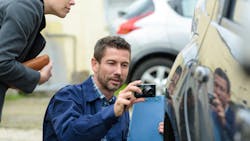In this article, we will explore some more advanced process tricks to enable lean production flow. We will look for ways to get things done in advance of the flow line, to ensure work flows out with high quality, with very fast cycle times, and consistent flow each day.
In previous articles we have discussed setting production goals, then building a level daily schedule to keep the shop at its Optimal Work in Progress. This article will describe process tools top shops around the globe use, to reduce overall repair cycle time.
Advanced Inspections
One of the interesting innovations I observed in the United Kingdom was the estimator certification program and their ability to use the “advanced inspection” to get 95% of the parts pre-ordered. They have R & I tools in the inspection bay to partially disassemble the damaged vehicles. If the damage is too severe, they are unsafe to drive and are put in rental and a teardown is completed right away.
The result is they begin repairs nearly immediately, don’t wait for parts to continue, and use the body repair team to prebuild the vehicles so any minor parts that were missed can be ordered and received while the vehicle is in the flow line.
720-degree Mirror Matching
My friend Scott Wheeler of Axalta teaches a trick relative to mirror-matching parts. They perform a 360-degree inspection of the inside of the part and then another 360-degree inspection of all angles of the exterior, with headlights being checked to verify the color spectrum matches.
The result is we rarely wait to replace a wrong or damaged part.
Painting Parts off Vehicles and Transferring During Repair-Planning
After learning about advanced inspections from Jon Parker, our USA innovator, Marshall Auto Body really mastered the painting of parts prior (in advance of drop or immediately after dropping off and verification) to repair-planning. This enables Dual-Processing where a vehicle can be OEM-researched, pre-scanned, prewashed, and mechanical diagnosis can be done while parts are painted on both sides. This enables them to bring the part painted on both sides to the vehicle on a stand DURING DISASSEMBLY and technicians can literally “transfer” parts from the damaged part to the replacement part. This works best for complex assemblies such as liftgates, doors, bumpers, etc.
The result is a significant reduction in second and third supplement and a way faster cycle time.
Body Building-up Prior to Flow Line
One innovation I learned from John Swiegart was to build up the vehicle in the body shop so the reassembly can be completed in one to two hours or less. This means A, B, and C pillars, engine bays, core supports, and other inner areas are painted (safely) in the body repair area. This allows interiors to be reinstalled, engines and most underhood or trunk parts to be reassembled in the Body Department. By building these things up there, the final reassembly is merely door handles and final installation of interior trim and exterior emblems.
The result is level flow in the flow line, and it makes dedicating staff to disassembly and reassembly more of a reality.
Avoiding Parts Delays
The German shops Jon Parker works with really use advanced inspection to identify most parts to replace at the time of the inspection, but immediate pre-scan, mechanical diagnosis, and pre-paint and transfer ensures the first supplement is almost always the last. Verifying part prices at the time of placing the order prevents part price increase supplements.
The result of mirror-matching catches wrong or damaged parts from causing delays.
Flow Line
An innovation which started in Italy is to have a linear flow line. This process is also widely used at auto auction facilities across the USA. The flow line is the part of the shop from final bodywork (primer-ready) through prime and block, staging, paint, reassembly, and detail. This process should be able to function on a drumbeat / rhythm or takt of a defined increment (often 70-80 minutes). At those increments, the vehicles should be able to move one stage downstream in the process. Therefore, a vehicle which has $3,000 in repairs would be able to move through the flow line in six to seven hours. If all the setup has been done correctly, the vehicle should not have to stop during the below process:
Plan
- Review paint-related work order items
- Locate all parts from parts carts or paint carts
- Set up parts on prime or paint stands
- Prep raw plastic
Prep
- (Prep curtains MUST be drawn and dust extraction used)
- Prime (assumes body delivers repairs in “primer-ready” state)
- Block
Stage
- Move parts primed to 360-degree flipper-style racks with no sanding dust
- Orient the vehicle and parts the way they will be set up in the booth
- Mix sealer (if used), base and clear per the color verified during advanced inspection
- Clean vehicle for masking
- Mask the skeleton or edge of the painted area
- Bag entire vehicle, cut out painted openings, tape down the cut-outs to the skeleton masking
- Final wash and pre-tack
Reassembly
- Final reassembly
- Calibrate systems
- Test-drive
- Post-scan
Wash and vacuum (assume vehicle was pre-washed)
- Remove any minor paint imperfections
- Remove protection from interior
- Final-detail interior and door jambs
- Final detail trunk and gas cap door
- Final-detail underhood and bumper
- Wash and dry entire vehicle
- Pull into the delivery stall
Zero-Day Repairs
This is a designation started in the United Kingdom and The Netherlands, where 20-35% of repairs are completed using this process, as their damage tends to be smaller in scope due to vehicle size and accident speeds. This process is used for repairs with minimal repair work to be completed, generally four to six hours of total repair time. The idea with these repairs is to check them in the morning and deliver them on the same day at the end of the day. Below are some keys to make this work:
“Advanced Inspection” performed to write a thorough estimate to ensure all parts are pre-ordered.
Begin repairs immediately upon arrival, often going directly into the flowline, and having the prep team perform disassembly and reassembly.
Color verification occurs during advanced inspection with the spectrophotometer so parts can be pre-ordered.
In the next article, we will further explore implementation of lean principles in the collision repair space.
About the Author
Steve Trapp
Steve Trapp is an internationally known consultant and speaker. His family operates a collision repair center in Wisconsin. He earned a degree in economics education and a minor in accounting from the University of Wisconsin.
After college, he worked for 3M in sales and marketing roles with the innovative 3M ARM$ training and software sales. He worked as a consultant for AutocheX doing financial consulting for a few years before joining AkzoNobel, where he started the industry’s first value-added program. While there, he started the industry’s first paint company-sponsored 20 groups and wrote numerous training programs with third-party experts on finance, marketing, selling, leadership, and other topics.
He later joined DuPont/Axalta, where he worked with Mike Anderson to manage their 20 groups and industry seminars. While at Axalta, he managed the North American Strategic Accounts SAM team and later the entire EMEA Strategic Accounts team. He followed that as senior consultant for LEAP, a global consulting firm that has presented in 10 countries and now again works for a major paint company.


